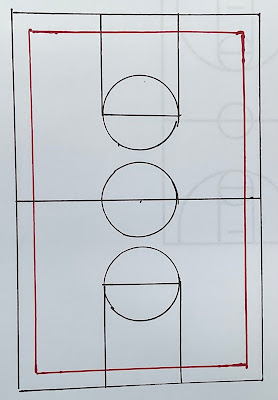High school players from 1900 to 1950 seldom played games on a regulation 84 foot basketball court. Most court were around 64 feet. That often meant the top of the key and the center circle were either very close to each other or they even overlapped.
In the 1930’s, my father at Fulton always scheduled one game at Wharton FH vs Moline. It was a rare opportunity to play on an 84 foot court.
With small courts, there were many unusual ground rules to cover unusual things. For many early gyms, seating was in a balcony. It was not unheard of for the balcony to go over the court and have support poles on the court. Generally if the ball hit the pole, they played it as still live unless it went out of bounds. Some schools considered an overhanging balcony as being inbounds while others considered it out of bounds.
A “regulation” basketball court is 84 feet long. Up until the 1960’s it was not common for high school courts to be only 64 feet. And many of the gym had only 1-2 feet between the wall and the out of bounds lines. The short court for high school play became uncommon by the 1960’s, but remained common for junior high gyms.
One of the issues of courts with “tight walls” was when a team took the ball out of bounds. If the defense got right up on the inbounds passer, the passer felt double teamed by the defender and the wall. That made it very tough to inbounds the ball.
To adjust to the “tight walls”, a three foot restraining line was put all the way around the court. In the drawing, it is the red line.
1- The inbounds passer could go up to the line.
2- The defense could not cross the red line.
3- The passer could not bounce the ball in the area between the out of bounds line and the red line.
4- Neither a receiver or a defender could enter the area between the red line and the out of bounds line.
All of this sounds complicated. When I was in junior high, our gym had the line. It was horribly complicated for a JH player. In simpler terms- when the ball was entered from out of bounds- the out of bounds line became the red line. When the ball was taken out, the court was shrunk. Once the ball was entered, the red line had no impact on the game. The out of bounds line went back to being the normal line.
This diagram is of a normal size 84 foot basketball court. You will note the space between the top of the key and the half-court line. The offense has a space to run their offense.
This diagram shows what happens on a shortened 64 foot court. The space between the top of the key and the half court line shrinks dramatically. Some small courts actually had the top of the key intersect with the half court line. With a shorter court, something needed to be done to provide the offense room to operate.
On small courts, the half court line became the traditional 10 second line. If a team was being pressed, they had 10 seconds to cross half-court.
When the Home team was going to basket A, once they crossed the 10 second line, the 10 second line no longer had any effect- it was too close to be the over and back line. So when going to basket A, when a team crossed mid-court, the mid-court line no longer had impact on play. The over and back line went back to the red line marked A. This allowed the offense to have space to operate. The same was true when going the other direction- half-court was the 10 second line and the red line marked “B” became the over and back line.




I played high school basketball for Costa in the old Corpus Christi Gym in the late 60’s. There was a restraining line all around the gym; at the ends because there was only about a foot between the wall and the end line and on the side because there was only bleachers we’re only a foot or so from the out of bounds line.
ReplyDeleteThe ROWVA junior high gym had restraining lines all around until it closed around 2013. The lines provided a home court advantage as the visiting team always had a few line violations. The Winona junior high gym had the three midcourt lines until the school closed around 1990.
That is interesting- thanks!! As a Knox freshman, we played CSC at Corpus, I remember you felt like everybody was right on top of you.
DeleteWhen we played Limestone and John Gross was the coach, they had an open stage on one baseline and a wall two feet from the out of bounds at the other. In second half the visitors always took it out after a made basket at the tight wall end. Gross ALWAYS slapped on a full court press- no restraining line- all over the inbounder.
Again- thanks for sharing!!